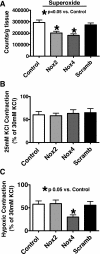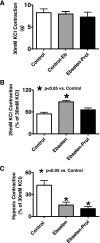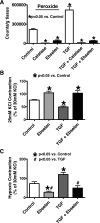Roles for Nox4 in the contractile response of bovine pulmonary arteries to hypoxia
- PMID: 20304813
- PMCID: PMC2886632
- DOI: 10.1152/ajpheart.01228.2009
Roles for Nox4 in the contractile response of bovine pulmonary arteries to hypoxia
Abstract
Hypoxia appears to promote contraction [hypoxic pulmonary vasoconstriction (HPV)] of bovine pulmonary arteries (BPA) through removal of a peroxide-mediated relaxation. This study examines the roles of BPA Nox oxidases and mitochondria in the HPV response. Inhibitors of Nox2 (0.1 mM apocynin and 50 muM gp91-dstat) and mitochondrial electron transport (10 muM antimycin and rotenone) decreased superoxide generation in BPA without affecting contraction to 25 mM KCl or the HPV response. Transfection of BPA with small inhibitory RNA (siRNA) for Nox2 and Nox4 decreased Nox2 and Nox4 protein expression, respectively, associated with an attenuation of superoxide detection, without affecting 25 mM KCl contraction. However, Nox4 siRNA, but not Nox2, attenuated HPV in BPA. A Nox4 inhibitor plumbagin (10 muM) increased basal force, decreased superoxide detection and peroxide release, and caused BPA to relax under hypoxia. Although acute removal of peroxide with 0.1 mM ebselen increased 25 mM KCl contraction and decreased hypoxic contraction, prolonged treatment with ebselen only decreased hypoxic contraction without affecting 25 mM KCl contraction, suggesting basal peroxide levels also maintain a contractile mechanism not removed by acute hypoxia. Organ culture of BPA with transforming growth factor (TGF)-beta1 (4 nM) increased Nox4 expression, superoxide, peroxide, and the HPV response. Thus Nox2 and mitochondria are sources for superoxide generation in BPA, which do not appear to influence the HPV response. However, peroxide derived from superoxide generated by Nox4 appears to maintain a basal relaxation in BPA under normoxic conditions, which is removed under hypoxia leading to HPV. Peroxide generated by Nox4 may also function to maintain a contractile mechanism, which is not reversed by acute hypoxia.
Figures











Similar articles
-
Potential role of cartilage oligomeric matrix protein in the modulation of pulmonary arterial smooth muscle superoxide by hypoxia.Am J Physiol Lung Cell Mol Physiol. 2019 Nov 1;317(5):L569-L577. doi: 10.1152/ajplung.00080.2018. Epub 2019 Aug 7. Am J Physiol Lung Cell Mol Physiol. 2019. PMID: 31389735 Free PMC article.
-
Heme oxygenase-1 induction modulates hypoxic pulmonary vasoconstriction through upregulation of ecSOD.Am J Physiol Heart Circ Physiol. 2009 Oct;297(4):H1453-61. doi: 10.1152/ajpheart.00315.2009. Epub 2009 Aug 7. Am J Physiol Heart Circ Physiol. 2009. PMID: 19666846 Free PMC article.
-
Mitochondrial-derived hydrogen peroxide inhibits relaxation of bovine coronary arterial smooth muscle to hypoxia through stimulation of ERK MAP kinase.Am J Physiol Heart Circ Physiol. 2009 Dec;297(6):H2262-9. doi: 10.1152/ajpheart.00817.2009. Epub 2009 Oct 23. Am J Physiol Heart Circ Physiol. 2009. PMID: 19855056 Free PMC article.
-
Oxidant-redox regulation of pulmonary vascular responses to hypoxia and nitric oxide-cGMP signaling.Cardiol Rev. 2010 Mar-Apr;18(2):89-93. doi: 10.1097/CRD.0b013e3181c9f088. Cardiol Rev. 2010. PMID: 20160535 Free PMC article. Review.
-
Redox regulation of responses to hypoxia and NO-cGMP signaling in pulmonary vascular pathophysiology.Ann N Y Acad Sci. 2010 Aug;1203:126-32. doi: 10.1111/j.1749-6632.2010.05557.x. Ann N Y Acad Sci. 2010. PMID: 20716294 Review.
Cited by
-
Molecular mechanisms of the crosstalk between mitochondria and NADPH oxidase through reactive oxygen species-studies in white blood cells and in animal models.Antioxid Redox Signal. 2014 Jan 10;20(2):247-66. doi: 10.1089/ars.2012.4953. Epub 2013 Aug 17. Antioxid Redox Signal. 2014. PMID: 23845067 Free PMC article.
-
Hypoxic pulmonary vasoconstriction.Physiol Rev. 2012 Jan;92(1):367-520. doi: 10.1152/physrev.00041.2010. Physiol Rev. 2012. PMID: 22298659 Free PMC article. Review.
-
Potential role of cartilage oligomeric matrix protein in the modulation of pulmonary arterial smooth muscle superoxide by hypoxia.Am J Physiol Lung Cell Mol Physiol. 2019 Nov 1;317(5):L569-L577. doi: 10.1152/ajplung.00080.2018. Epub 2019 Aug 7. Am J Physiol Lung Cell Mol Physiol. 2019. PMID: 31389735 Free PMC article.
-
ICAM-1 cytoplasmic tail regulates endothelial glutathione synthesis through a NOX4/PI3-kinase-dependent pathway.Free Radic Biol Med. 2010 Sep 15;49(6):1119-28. doi: 10.1016/j.freeradbiomed.2010.06.030. Epub 2010 Jul 13. Free Radic Biol Med. 2010. PMID: 20633529 Free PMC article.
-
Pulmonary endothelial cell NOX.Am J Respir Cell Mol Biol. 2012 Aug;47(2):129-39. doi: 10.1165/rcmb.2010-0331RT. Epub 2012 Apr 12. Am J Respir Cell Mol Biol. 2012. PMID: 22499852 Free PMC article. Review.
References
-
- Archer SL, Huang J, Henry T, Peterson D, Weir EK. A redox-based O2 sensor in rat pulmonary vasculature. Circ Res 73: 1100–1112, 1993 - PubMed
-
- Archer SL, Will JA, Weir EK. Redox status in the control of pulmonary vascular tone. Herz 11: 127–141, 1986 - PubMed
-
- Bradford MM. A rapid and sensitive method for the quantitation of microgram quantities of protein utilizing the principle of protein-dye binding. Anal Biochem 72: 248–254, 1976 - PubMed
Publication types
MeSH terms
Substances
Grants and funding
LinkOut - more resources
Full Text Sources
Molecular Biology Databases
Miscellaneous

